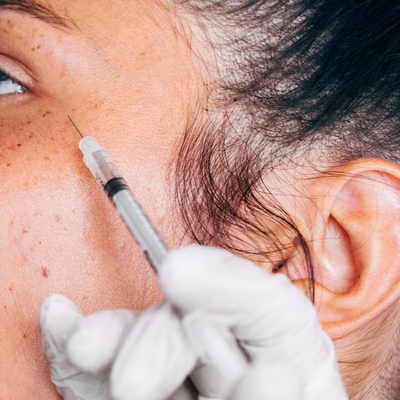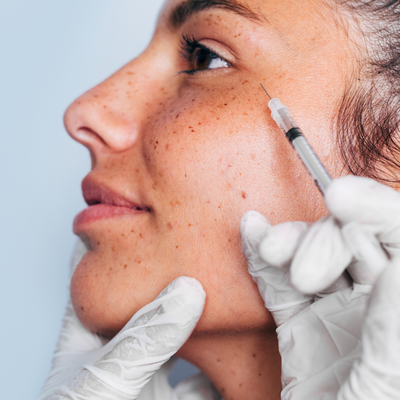

Considering Botox? Two Experts Share What To Consider First
First & Foremost, Do Your Research
“Research is the most important thing you can do before Botox. You are thinking of having something injected into your face – surely you want to know everything you can about that and the procedure first? You’ll be surprised by how many of your friends are secretly having it done. They’ll have that natural, fresh look that many of us seek. It’s why recommendations are also essential. You should also always ask, who is the practitioner? What are their qualifications? And how long have they been doing it? I recommend checking for affiliations such as BCAM (British Colle of Aesthetic Medicine) and registration with the GMC (General Medical Council) – this means that they are fully vetted and trustworthy.” – Dr. Richard Sibthorpe, Expert in Advanced Aesthetic Treatments
Consider Why You’re Doing It
“It’s essential to consider why you’re having Botox done. Really think about whether you need it, or whether you’re having it done because you feel you should, or because your friends are doing it. You should be prepared to follow the post-procedure advice for two to three days after having it done, if you cannot then it’s better to postpone or not have it done at all. For example, you must not engage in any strenuous exercise for 48 hours’ post-treatment and it is important to sleep on your back for two nights after the treatment. It is essential to consider the acute and long term costs too. I usually recommend two to three sessions per year depending on age and the amount of ageing present so patients need to financially plan.” – Dr. Bibi Ghalaie, Cosmetic Physician At Doctor Bibi Clinic
Start Off Small
“As Bibi says, ask yourself why you’re doing it. If you see the signs of ageing when you look in the mirror – like wrinkles and heavy frown lines – then yes, Botox can work well. It doesn’t always have to be the maximum amount immediately, either. Start with ‘Baby Botox’ which is just a small amount. This way, you can see if you like it. You can always have more as part of a review or adjustment.” – Richard
Think About The Look You Want
“Consider whether you want to achieve a frozen/static look or a more natural one that leaves behind expression. You may think you can decide down the line, but preparation in this aspect is key. It comes back to doing research – look at the type of effects you want to create. Everyone is different and will want a different aesthetic – both are achievable depending on the patient’s desire. It’s also worth noting that there are some conditions which contraindicate the use of Botox. Patients should consider whether they have any of these that would preclude them from safely having Botox. For example, people with myasthenia gravis, people taking certain medications such as aminoglycosides, and also women who are pregnant or breastfeeding should all avoid the use of Botox. Lastly, it is not ideal to have this treatment or any injectables done right before a big or important event like a wedding, for example. Why? Because it takes about two weeks for the results to kick in and settle, secondly downtime for any possible bruising needs to be considered too.” – Bibi
Know The Needles Are Tiny
“A lot of people fear the needles with Botox but it’s worth noting that the ones we use are very fine. Because of this, most people don’t find Botox to be too painful. If you know your practitioner is skilled, you should also be reassured knowing that any discomfort will be kept to a minimum. It is possible you could get a bruise, but that is less common these days, nevertheless, consider whether you should go back to work after or not once having had it done.” – Richard
Understand How Filler & Botox Differ
“Confusing the indications for these two treatments is very common. For example, patients will often come in to my clinic asking if they can have Botox in their lips. Botox is a muscle relaxing treatment that is injected into facial muscles and aimed at treating the lines and wrinkles that form when a muscle contracts. As such, it is not effective for deep-set lines. It can soften a superficial line, but it will not fill a deep-set line. Instead, it will stop these lines from turning into static lines and, in this way, it can be both therapeutic and preventative. Botox is most commonly used for treatment of upper face lines, including the forehead lines, frown lines and crow’s feet, but it has a multitude of uses in other facial areas, and can also be used to treat migraines, excessive sweating and even neck pain. Fillers, on the other hand, are gel volumisers. They do not prevent muscle contraction; they are injected with the aim of filling a crease or creating volume. They are not injected into muscles but rather into the skin or area beneath the skin.” – Bibi

STUDIO FIRMA/STOCKSY UNITED
Prepare The Right Way
“Ideally, every patient would attend their appointment without make-up on and they would avoid alcohol, retinol and vitamin E the day before having Botox. These things can increase the risk of bleeding and bruising. Prepare by reading up on all the clinical indications and effects too. That way you’re armed with information and can ask your practitioner for their best advise on any of your concerns. I often recommend watching YouTube or social media videos created by the person doing your procedure too. It’s really important you inform your doctor or nurse if you have a needle phobia too. They will take extra precaution to put you at ease.” – Bibi
…And Take Stock Of Aftercare
“Before you have Botox, it’s worth knowing that aftercare is key, too. My biggest advice? Avoid touching the area you’ve had it done and don’t use make-up for a few hours afterwards. This way, you’ll avoid any infection. Bruising can be a common side effect for some, so ice and arnica after treatments can be useful.” – Richard
Attend Your Consultation
“Consultations are a very important part of the treatment – especially if you’re wary. Come to the consultation with all your questions written down so you don’t forget to ask anything. It’s often a time we can alleviate your concerns, too. Some practitioners charge, but usually waive the fee if you proceed to have the treatment with them. Either way, it’s well worth yours – and our – time.” – Richard
Learn All Your Options
“If you are new to injectables and not keen on Botox, there are other alternatives worth considering. Medical grade skincare and certain skin boosters can be effective and often a gentle introduction to further treatments like Botox. These won’t stop muscle contraction but can be very effective for anti-ageing results. If you do want to try Botox, it’s also worth noting there are other treatment options you can pair it with for enhanced results. We used to believe that separating Botox and dermal fillers was the best way to treat ageing. However, research has shown combining these two has an impactful effect in the prevention of wrinkles and ageing. It’s worth considering and speaking to your specialist if this is of interest. It also goes without saying that combining Botox with good skincare, regular SPF and a well-balanced diet – as well as no smoking – will help to enhance your appearance overall.” – Bibi
Be Aware Of Costs
“Botox fees do vary, but there is a set formula that’s worth knowing. Fees are set out according to the number of areas you have treated – from one to three as a rule. Fees may go up or down depending on where you are in the UK and who the practitioner is, but typically, you’re looking at £200-£500. Anything that seems overly cheap or much more expensive than this should be queried.” – Richard
Final Takeaway Advice…
“Botox is safe, reliable, consistent and effective in experienced hands. I am a great believer in not overdoing it, however. I recommend having no more than three sessions per year. This is because evidence shows that having back-to-back sessions and not allowing your facial muscles the opportunity to have some movement can cause your facial muscles to lose tone. It’s why mine – and others – general aesthetic philosophy is ‘less is more’ and it’s worth knowing this before you undergo any Botox yourself.” – Bibi
Considering Botox? These Are Five Of The Best Experts...
Dr Bibi Ghalaie, @DoctorBibiClinic
Dr Richard Sibthorpe, DoctorSib.com
Dr Maryam Zamani, DrMaryamZamani.com
Dr Wassim Taktouk, DrWassimTaktouk.com
Natali Kelly, NataliKelly.com
DISCLAIMER: Features published by SheerLuxe are not intended to treat, diagnose, cure or prevent any disease. Always seek the advice of your GP or another qualified healthcare provider for any questions you have regarding a medical condition, and before undertaking any diet, exercise or other health-related programme.
DISCLAIMER: We endeavour to always credit the correct original source of every image we use. If you think a credit may be incorrect, please contact us at info@sheerluxe.com.